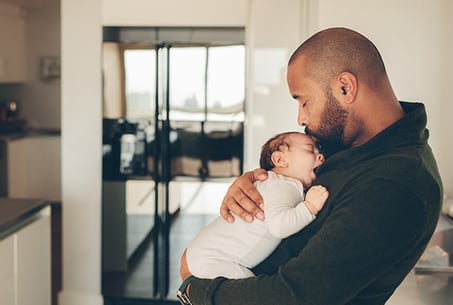Becoming a new father – The transition to fatherhood
9 min read
Date Published: 04/11/2023
Last Updated: 12/26/2023
National Fatherhood Initiative Blog / Latest Articles
9 min read

What’s the most fascinating, new area of fatherhood research?
For a research nerd like me, it’s the biological connection between dads and their children. I’m not talking about the DNA dads contribute to their offspring. I’m talking about the changes that take place in dads’ biology during the prenatal and postnatal periods that prepare them for the most vital role of their life.
That’s why I was so pleased to run across the best, concise summary I’ve seen of this burgeoning and exciting area of research. The article below appeared in the Child and Family Blog, a recent addition to our Free Learning Center for its outstanding collection of fatherhood-related research. You’ll enjoy reading it.
For more research on the biological connection between fathers and their children, order Father Facts. It contains an entire chapter of studies examining this connection. I also encourage you to order our New and Expectant Dads and Father Involvement Starter bundles to build this connection in the dads you serve. In building this connection, you’ll increase the chance that dads will stay involved in their children’s lives for the long haul!
Christopher A. Brown, president, National Fatherhood Initiative®
This article is written by Marian J. Bakermans-Kranenburg and Marinus H. van IJzendoorn for the Child & Family Blog. It is republished here with permission.
Babies are ready to meet their fathers, and fathers’ hormones and brains are ready to adapt to this new phase of life.
Key takeaways for caregivers
The birth of a child is the birth of a father
The birth of the first child marks the transition to fatherhood in men’s lives. This is a developmental milestone, a new phase in adult life with unfamiliar tasks and responsibilities. The transition is more striking for most men who become fathers now than it was for their fathers and grandfathers.
Today, fathers in Western, industrialized countries are much more actively involved in child care than their fathers were: a three- to six-fold increase in time over what their own fathers typically did. How are men prepared for the life-changing event of becoming a father?
Hormonal changes in new fathers
The changes in hormonal levels in women who go through pregnancy and give birth are unparalleled. These are necessary for housing and feeding a new human being. In the transition to fatherhood, men also undergo hormonal changes, although they are not as significant as those women experience.
From around four weeks before the birth of their first child to around five weeks after birth, men’s testosterone, vasopressin, and cortisol levels decrease, and their oxytocin levels slightly increase. These hormones are involved in many activities.
Testosterone is relevant when we are daring and competitive, vasopressin makes us alert, cortisol helps us respond to unexpected situations and is high when we are under stress, and oxytocin is well known as the love hormone but has more functions: It helps us recognize social signals, such as others’ emotions. These hormonal changes in fathers can be considered as functional for gentle interaction with and sensitive care for the baby.
The perinatal period
But it could also be the other way around: In the perinatal period, the new activities and routines of fathers may lead to changes in their hormone levels, which in turn support sensitive parenting.
For example, when fathers spend a few evenings a week on the couch cuddling with their baby rather than playing football, their cortisol levels probably decline and their oxytocin levels probably rise. This, in turn, may make them more patient when the baby protests during diaper changes. This idea of caregiving routines leading to change in hormonal levels is supported by new research on fathers’ brains.
Do men’s brains change when they become fathers?
There are (at least) three different ways to study human brains to measure change:
1. Brain structures
The first is to look at brain structures, which can be seen as the hardware of the brain. Two studies found some change in fathers’ brain structures in the first months after the birth of the baby (Kim at al., 2014; Martínez-García et al., 2022), but another study did not find such changes (Hoekzema et al., 2016).
2. Activity of brain areas
The second way to study brains is to look at the activity of brain areas in response to child-related stimuli. Much of this research focuses on the sounds of infants crying because that is such an intense and meaningful sound. In their first period of life, it is the only way babies can attract their parents’ attention when they need something.
Indeed, many brain regions are activated when we hear crying sounds. But having children does make a difference: Adults without children show more activity in brain regions involved with cognitive processing when they hear infants crying, while adults with children show more emotional processing (Witteman et al., 2019).
3. Brain networks
While this second type of brain research focuses on separate brain regions, the third type of brain research looks at brain networks. For example, the parental brain network is a system of regions that are supposed to collaboratively support caregiving behavior.
New research shows no differences in this network between fathers during pregnancy and new fathers with a first-born baby of about 2 months, but a remarkable finding for fathers in the postnatal period emerged: The more fathers were involved in their children’s care, the stronger the connectivity in their parental brain network (Horstman et al., 2021). In other words, it does not matter whether or not men have a baby, but it matters how much caretaking they do.
Play helps fathers connect with their babies
Fathers and mothers are both similar and different in the ways they engage with their children. In general, mothers do the lion’s share of caregiving, such as feeding and bathing. When it comes to play, fathers and mothers are more similar in the amount of time they play or read stories with their child. This implies that when fathers and infants interact, it is often in the context of play (Amodia-Bidakowska et al., 2020).
Play is a perfect way for fathers to get to know their child, and to see what they like, what fears they may have, and how they overcome these fears with daddy’s help. This is as rewarding for fathers as it is for children, and it stimulates the attachment relationship (Monteiro et al., 2010).
Positive parenting in fathers starts with prenatal care
We stated earlier that the birth of a child is the birth of a father. Actually, being a parent starts before the birth of the child. Fathers are influential during pregnancy – they affect prenatal development through their own health, and they influence expectant mothers’ mental and physical health.
New research also shows that unborn babies are ready to interact with their fathers. Using ultrasound, we recorded how babies between the 21st and 32nd week of pregnancy responded when their fathers softly massaged mothers’ abdomen, read from a children’s book, or sang for their child (De Waal et al., 2022).
Babies can hear voices coming from outside the abdomen and can recognize their father’s voice. They can remember rhythms and music during pregnancy and even after birth when they heard them regularly during pregnancy. As pregnancy progresses, the skin of mothers’ abdomen thins, there is less amniotic fluid, and the babies’ nervous system develops, enabling them to feel and respond to touch.
In our research, we offered fathers three sessions with ultrasound-based interaction with their unborn baby. We saw on the screen how the babies responded when their fathers read to them from a children’s book or sang a lullaby. We used video-feedback reviewing of the ultrasound images to help them interpret their babies’ states, responses to the interaction (e.g., thumb sucking when dad read), and own initiatives (e.g., pushing against the wall of mother’s womb).
Fathers who received such prenatal video feedback were more sensitive during play with their babies after birth (Buisman et al., 2022). The video feedback may have made these dads more attuned to their babies, and may have spurred them to habitually check their baby’s face and other signals to adapt their own behavior or pace to the infant’s needs.
How to support new fathers during the prenatal period and after the birth
Fatherhood has many dimensions. The transition to fatherhood is accompanied by changes in behavior, hormones, and the brain. The intensity of these changes depends partly on sociocultural norms and expectations for fathers.
Sometimes fathers feel at a disadvantage: Prenatal and perinatal care is focused on mothers, and fathers can seem to be at some distance. While it would be a great opportunity for medical check-ups to extend the focus of ultrasounds to include possibilities for father-infant interaction, fathers can also create their own moments of togetherness at home, talking to their babies and softly massaging their babies through their partners’ skin. Getting to know each other can start before birth.
Societies with parental leave for fathers stimulate paternal involvement in early child care, giving fathers more opportunities to interact with their babies. In such contexts, changes in brains and hormonal levels will probably be more extensive than in contexts where fathers have few opportunities to be actively involved in child care. Paternal leave enables fathers to develop a relationship with their children from the beginning, which is just one of the arguments for paid paternal leave.
In some families, opportunities for fathers to engage are limited by mothers’ reluctance to trust fathers’ caregiving capacities. Called gatekeeping, this occurs when mothers want to take complete care of the baby themselves. It may be good to realize that fathers can be excellent caregivers, just like mothers, and that fathers’ caretaking of their baby may promote the hormonal and brain changes that support high-quality fathering.
References
Amodia-Bidakowska A, Laverty C & Ramchandani PG (2020), Father-child play: A systematic review of its frequency, characteristics and potential impact on children’s development, Developmental Review, 57, 100924
Bakermans-Kranenburg MJ, Lotz AM, Alyousefi-van Dijk K & Van IJzendoorn MH (2019), The birth of a father: Fathering in the first 1,000 days, Child Development Perspectives, 13
Bakermans-Kranenburg MJ, Verhees MW, Lotz AM, Alyousefi-van Dijk K & van IJzendoorn MH (2022), Is paternal oxytocin an oxymoron? Oxytocin, vasopressin, testosterone, oestradiol and cortisol in emerging fatherhood, Philosophical Transactions of the Royal Society B, 377
Buisman RSM, Alyousefi-van Dijk K, de Waal N, Kesarlal AR, Verhees MWFT, Van IJzendoorn MH & Bakermans-Kranenburg MJ (2022), Fathers’ sensitive parenting enhanced by prenatal video-feedback: A randomized controlled trial using ultrasound imaging, Pediatric Research
De Waal N, Alyousefi-van Dijk K, Buisman RSM, Verhees, MWFT & Bakermans-Kranenburg, MJ (2022), The prenatal Video-feedback Intervention to Promote Positive Parenting for expectant fathers (VIPP-PRE): Two case studies, Infant Mental Health Journal
Fernandes C, Monteiro L, Santos AJ, Fernandes M, Antunes M, Vaughn BE & Veríssimo M (2019), Early father–child and mother–child attachment relationships: contributions to preschoolers’ social competence, Attachment & Human Development
Hoekzema E, Barba-Müller E, Pozzobon C, Picado M, Lucco F, García-García D, …Vilarroya O (2016), Pregnancy leads to long-lasting changes in human brain structure, Nature Neuroscience, 20
Horstman LI, Riem MM, Alyousefi-van Dijk K, Lotz AM & Bakermans-Kranenburg MJ (2021), Fathers’ Involvement in Early Childcare is Associated with Amygdala Resting-State Connectivity, Social Cognitive and Affective Neuroscience
Kim P, Rigo P, Mayes LC, Feldman R, Leckman JF & Swain JE (2014), Neural plasticity in fathers of human infants, Social Neuroscience, 9 Monteiro L, Veríssimo M, Vaughn BE, Santos AJ, Torres N & Fernandes M (2010), The organization of children's secure base behaviour in two-parent Portuguese families and father's participation in child-related activities, European Journal of Developmental Psychology, 7
Witteman J, Van IJzendoorn MH, Rilling JK, Bos PA, Schiller NO & Bakermans-Kranenburg MJ (2019), Towards a neural model of infant cry perception, Neuroscience & Biobehavioral Reviews, 99
Authors
 Marian J. Bakermans-Kranenburg - Professor of Child & Family Studies a ISPA, Lisbon, Portugal Marian J. Bakermans-Kranenburg - Professor of Child & Family Studies a ISPA, Lisbon, Portugal |
 Marinus H. van IJzendoorn - Visiting Professor in the Research Department of Clinical, Education and Health Psychology, Faculty of Brain Sciences, University College London, UK. Marinus H. van IJzendoorn - Visiting Professor in the Research Department of Clinical, Education and Health Psychology, Faculty of Brain Sciences, University College London, UK. |
Date Published: 04/11/2023
Last Updated: 12/26/2023
Download the ebook to learn how to create fatherhood initiatives that engage every sector of community life.

Train Your Staff
Fatherhood Programs
Fatherhood Data
© 2025 National Fatherhood Initiative®. All rights reserved.